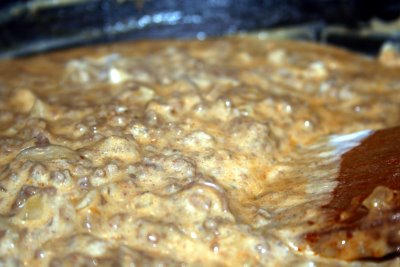Apple cider mahogany sauce may take several hours to prepare. But the rewards are great, both in terms of great seasonal flavor and pleasant aromas that waft through the house as you reduce apple cider into syrupy goodness.
This article is really about two sauces. First, you must reduce unfiltered apple cider to about 25 percent of its original volume. Once reduced, you can prepared the apple cider mahogany sauce.
While you can prepare sufficient quantity of the apple cider reduction for your current recipe project, I like to reduce a half-gallon or more at a time. This gives me a supply of syrup to use as I see fit.
Use the cider reduction as a stand-in for maple syrup or honey in almost any recipe. Let your imagination be your guide. The recipe for apple cider mahogany sauce is included below. Three weeks ago I braised pork butt in cider reduction and chicken stock and served it with roasted carrots.
My next project is to prepare Brussels sprouts by first roasting with caraway and mustard seeds, then braising in chicken stock and cider reduction. The cabbages will be good alongside bratwurst, fried potatoes and homemade sauerkraut.
To prepare the reduction, boil unfiltered apple cider (
I use Barsotti cider) over high heat until reduced to one-fourth its beginning volume, stirring occasionally. Skim surface build up as it collects. Allow as little as 45 minutes and as long as two hours to complete the reduction. The quantity being reduced, size and shape of the saucepan and heat setting determine how long it takes.
Brush cider mahogany sauce on grilled pork chops (pictured above) or sautéed chicken breasts. Dip sliced tri-tip (roasted to medium doneness) or smoked brisket in the sauce, quickly sear on griddle and place on toasted French roll. You can use the sauce to glaze your favorite cuts of lamb, pork, poultry or fish.
APPLE CIDER MAHOGANY SAUCE
3 slices bacon, diced small
1/2 cup medium sweet onion, diced small
1 cup apple cider reduction
1 cup catsup
2 tablespoons cider vinegar
1 tablespoon Worcestershire sauce
1/2 teaspoon chopped fresh thyme
In a medium saucepan or skillet, sauté bacon and onion until onion is tender. Drain bacon drippings from skillet. Add cider reduction, catsup, vinegar and Worcestershire sauce, Simmer 10 to 15 minutes, stirring occasionally. Stir in thyme. Adjust seasoning. Makes 2-12 to 3 cups.


















































